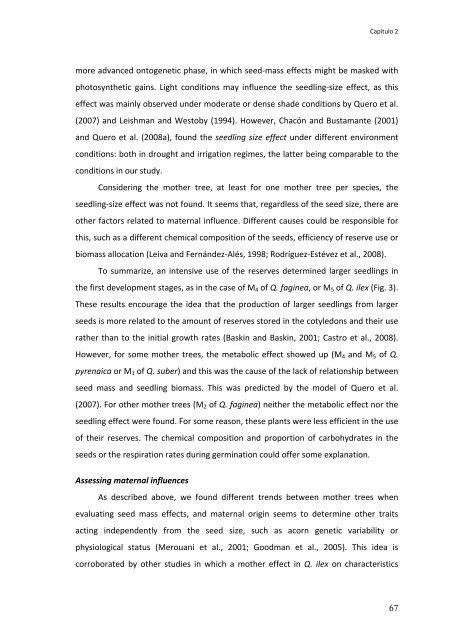Establecimiento de cuatro especies de Quercus en el sur de la ...
Establecimiento de cuatro especies de Quercus en el sur de la ...
Establecimiento de cuatro especies de Quercus en el sur de la ...
You also want an ePaper? Increase the reach of your titles
YUMPU automatically turns print PDFs into web optimized ePapers that Google loves.
Capítulo 2<br />
more advanced ontog<strong>en</strong>etic phase, in which seed‐mass effects might be masked with<br />
photosynthetic gains. Light conditions may influ<strong>en</strong>ce the seedling‐size effect, as this<br />
effect was mainly observed un<strong>de</strong>r mo<strong>de</strong>rate or <strong>de</strong>nse sha<strong>de</strong> conditions by Quero et al.<br />
(2007) and Leishman and Westoby (1994). However, Chacón and Bustamante (2001)<br />
and Quero et al. (2008a), found the seedling size effect un<strong>de</strong>r differ<strong>en</strong>t <strong>en</strong>vironm<strong>en</strong>t<br />
conditions: both in drought and irrigation regimes, the <strong>la</strong>tter being comparable to the<br />
conditions in our study.<br />
Consi<strong>de</strong>ring the mother tree, at least for one mother tree per species, the<br />
seedling‐size effect was not found. It seems that, regardless of the seed size, there are<br />
other factors r<strong>el</strong>ated to maternal influ<strong>en</strong>ce. Differ<strong>en</strong>t causes could be responsible for<br />
this, such as a differ<strong>en</strong>t chemical composition of the seeds, effici<strong>en</strong>cy of reserve use or<br />
biomass allocation (Leiva and Fernán<strong>de</strong>z‐Alés, 1998; Rodríguez‐Estévez et al., 2008).<br />
To summarize, an int<strong>en</strong>sive use of the reserves <strong>de</strong>termined <strong>la</strong>rger seedlings in<br />
the first <strong>de</strong>v<strong>el</strong>opm<strong>en</strong>t stages, as in the case of M 4 of Q. faginea, or M 5 of Q. ilex (Fig. 3).<br />
These results <strong>en</strong>courage the i<strong>de</strong>a that the production of <strong>la</strong>rger seedlings from <strong>la</strong>rger<br />
seeds is more r<strong>el</strong>ated to the amount of reserves stored in the cotyledons and their use<br />
rather than to the initial growth rates (Baskin and Baskin, 2001; Castro et al., 2008).<br />
However, for some mother trees, the metabolic effect showed up (M 4 and M 5 of Q.<br />
pyr<strong>en</strong>aica or M 1 of Q. suber) and this was the cause of the <strong>la</strong>ck of r<strong>el</strong>ationship betwe<strong>en</strong><br />
seed mass and seedling biomass. This was predicted by the mo<strong>de</strong>l of Quero et al.<br />
(2007). For other mother trees (M 2 of Q. faginea) neither the metabolic effect nor the<br />
seedling effect were found. For some reason, these p<strong>la</strong>nts were less effici<strong>en</strong>t in the use<br />
of their reserves. The chemical composition and proportion of carbohydrates in the<br />
seeds or the respiration rates during germination could offer some exp<strong>la</strong>nation.<br />
Assessing maternal influ<strong>en</strong>ces<br />
As <strong>de</strong>scribed above, we found differ<strong>en</strong>t tr<strong>en</strong>ds betwe<strong>en</strong> mother trees wh<strong>en</strong><br />
evaluating seed mass effects, and maternal origin seems to <strong>de</strong>termine other traits<br />
acting in<strong>de</strong>p<strong>en</strong><strong>de</strong>ntly from the seed size, such as acorn g<strong>en</strong>etic variability or<br />
physiological status (Merouani et al., 2001; Goodman et al., 2005). This i<strong>de</strong>a is<br />
corroborated by other studies in which a mother effect in Q. ilex on characteristics<br />
67

















